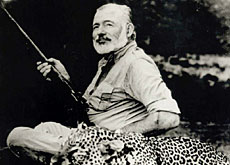The movers and shakers of Montreux

The walk begins as soon as one gets off the train at the Montreux station. It's called "On the Trail of Hemingway" and follows the footsteps of countless celebrities who left their mark on the resort in the 19th and 20th centuries.
“Hemingway was a traveller. He liked trains. His friends said he knew all the train timetables of the world by heart,” explains Evelyne Lüthi-Graf, Montreux’s archivist. She was responsible for creating the walk.
Hemingway is only one of the many celebrities or artists who eventually found fame and left their mark on Montreux. Lüthi-Graf named the walk after Hemingway because she says he was a “master of gossip”.
“If someone follows the trail of Hemingway they will find out about the famous people who stayed in Montreux. Hemingway would have liked that so it’s a bit of an homage to Hemingway.”
The Buffet de la Gare stands on the station platform, and it is where Hemingway set part of his short story, “A Homage to Switzerland”. Passengers can still have a coffee and a croissant while waiting for their train, as Hemingway did decades earlier.
“He was writing ‘A Farewell to Arms’ at that time. He came to the station with the Simplon-Montreux train and he had to wait for another train to take him up to Les Avants [where he rented a house],” Lüthi-Graf says.
“You can imagine him drinking a coffee,” she adds, “or a Bloody Mary – that would be more his style.”
Hemingway and the other celebrities are each represented by a red dot on the trail map, which gives a brief description of their accomplishments or, in some cases, escapades, while staying in Montreux.
Byron and Tchaikovsky
Byron stayed at a private house on Rue des Artisans after visiting Chillon Castle. The trip inspired the poem, “The Prisoner of Chillon”.
Montreux was also where the pharmacist, Henri Nestlé, developed the first milk formula for infants, where Stravinsky composed part of “Rite of Spring”, and where Tchaikovsky wrote “Concert for Violin”, after fleeing from his wife when he realised he could not stand living with a woman.
“If you take a boat out on to the lake from the quay you can sense what you hear in Tchaikovsky’s music,” says Lüthi-Graf. “The lake can be very calm or rough. You can compare it to what Tchaikovsky must of felt at that time when he discovered his homosexuality, and what it would have meant at that time.”
Tchaikovsky stayed in a villa on the quay (since torn down), which had previously been occupied by William the Third, King of the Netherlands. The king was well known for his eccentric behaviour.
“When the steamboats passed by on the lake he would go out on his balcony, open his bathrobe and expose himself,” Lüthi-Graf laughs. “There’s a police report demanding that the king stop bathing nude in front of the hotel.”
Not far away, the Montreux Palace hotel towers grandly above the quay. Vladimir Nabokov made it his home following the huge success of his novel, “Lolita”. To take his mind off his writing, he often went to catch butterflies in the alpine forests above Montreux.
Lüthi-Graf relates the story of a German film crew which had Nabokov pose with the butterfly net in the hotel garden, and pretend he was in the mountains. “His son Dmitri told me the story. Some newspapers caught wind of it and wrote that Nabokov was running around the city catching butterflies.”
Lolita grave
Leaving the quay, one follows a path called the “Sentier Mirabeau” to the cemetery of Clarens, one of the most beautiful parks in the area. It’s where Nabokov and many other celebrities are buried.
A recent edition of “Lolita” and a candle have been placed on his grave. It had rained earlier in the day, but the book was not wet so someone had obviously placed it there only hours before.
“I’ve never seen anything on the grave before,” says Lüthi-Graf. “But I’m sure if we come back a week from now it’ll still be here, even a month from now. It’ll only be removed when it has been completely destroyed by the elements.”
In the early evening the view from the quay is spectacular with its vista of the lake and the impressive Dents du Midi mountains.
“All the writers, all the painters, all the musicians said the same thing about the view from Montreux,” says Lüthi-Graf. “They said it’s wonderful to see the sun setting over the Dents du Midi. The Dents du Midi change from blue to pink and white to gold. It’s a magnificent place.”
Montreux’s main claim to fame is its famous residents, past and present. They include:
Lord Byron, poet
Elisabeth of Habsbourg, Empress of Austria and queen of Hungary
Ernest Hemingway, writer
Paul Krueger, South African politician
Henri Nestle, industrialist
Vladimir Nabokov, writer
Igor Feodorovitch Stravinski, composer
(This story was first published in 2001.)

In compliance with the JTI standards
More: SWI swissinfo.ch certified by the Journalism Trust Initiative









You can find an overview of ongoing debates with our journalists here . Please join us!
If you want to start a conversation about a topic raised in this article or want to report factual errors, email us at english@swissinfo.ch.